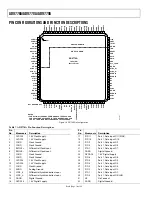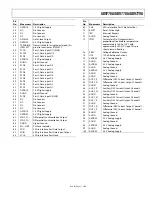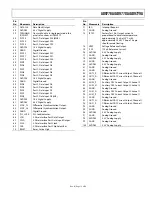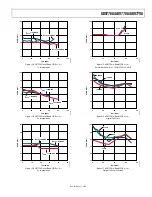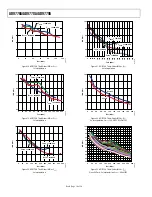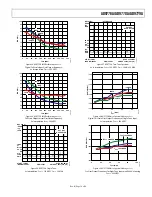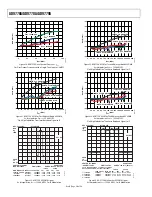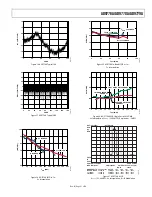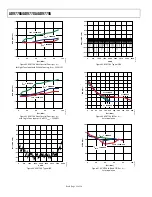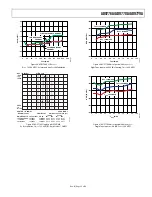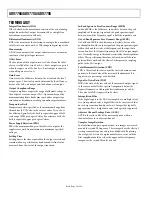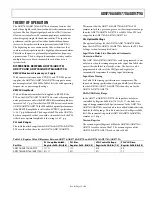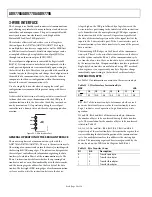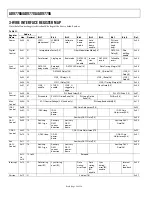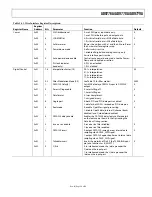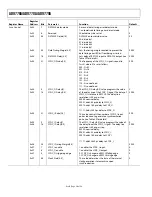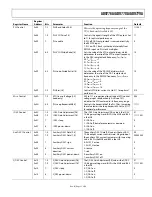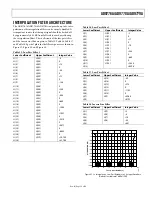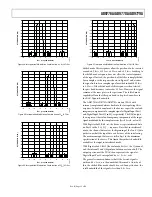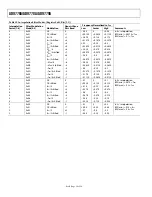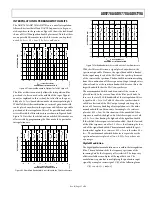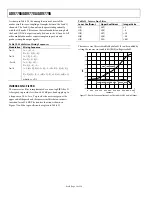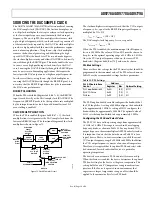
AD9776A/AD9778A/AD9779A
Rev. B | Page 24 of 56
TERMINOLOGY
Integral Nonlinearity (INL)
INL is defined as the maximum deviation of the actual analog
output from the ideal output, determined by a straight line
drawn from zero scale to full scale.
Differential Nonlinearity (DNL)
DNL is the measure of the variation in analog value, normalized
to full scale, associated with a 1 LSB change in digital input code.
Monotonicity
A DAC is monotonic if the output either increases or remains
constant as the digital input increases.
Offset Error
The deviation of the output current at Code 0 from the ideal
of zero is called offset error. For I
OUTA
, 0 mA output is expected
when the inputs are all 0s. For I
OUTB
, 0 mA output is expected
when all inputs are set to 1s.
Gain Error
Gain error is the difference between the actual and the ideal
output spans. The actual span is determined by the difference
between the full-scale output and the bottom-scale output.
Output Compliance Range
Output compliance range is the range of allowable voltage at
the output of a current-output DAC. Operation beyond the
maximum compliance limits may cause either output stage
saturation or breakdown, resulting in nonlinear performance.
Temperature Drift
Temperature drift is specified as the maximum change from
the ambient (25°C) value to the value at either T
MIN
or T
MAX
.
For offset and gain drift, the drift is reported in ppm of full-
scale range (FSR) per degree Celsius. For reference drift, the
drift is reported in ppm per degree Celsius.
Power Supply Rejection (PSR)
PSR is the maximum change in the full-scale output as the
supplies are varied from minimum to maximum specified
voltages.
Settling Time
Settling time is the time required for the output to reach and
remain within a specified error band around its final value,
measured from the start of the output transition.
In-Band Spurious-Free Dynamic Range (SFDR)
In-band SFDR is the difference, in decibels, between the peak
amplitude of the output signal and the peak spurious signal
between dc and the frequency equal to half the input data rate.
Out-of-Band Spurious-Free Dynamic Range (SFDR)
Out-of-band SFDR is the difference, in decibels, between the
peak amplitude of the output signal and the peak spurious signal
within the band that starts at the frequency of the input data
rate and ends at the Nyquist frequency of the DAC output sample
rate. Normally, energy in this band is rejected by the interpolation
filters. This specification, therefore, defines how well the inter-
polation filters work and the effect of other parasitic coupling
paths to the DAC output.
Total Harmonic Distortion (THD)
THD is the ratio of the rms sum of the first six harmonic com-
ponents to the rms value of the measured fundamental. It is
expressed as a percentage or in decibels.
Signal-to-Noise Ratio (SNR)
SNR is the ratio of the rms value of the measured output signal
to the rms sum of all other spectral components below the
Nyquist frequency, excluding the first six harmonics and dc.
The value for SNR is expressed in decibels.
Interpolation Filter
If the digital inputs to the DAC are sampled at a multiple rate of
f
DATA
(interpolation rate), a digital filter can be constructed that
has a sharp transition band near f
DATA
/2. Images that typically
appear around f
DAC
(output data rate) can be greatly suppressed.
Adjacent Channel Leakage Ratio (ACLR)
ACLR is the ratio in dBc of the measured power within a
channel relative to its adjacent channel.
Complex Image Rejection
In a traditional two-part upconversion, two images are created
around the second IF frequency. These images have the effect of
wasting transmitter power and system bandwidth. By placing
the real part of a second complex modulator in series with the
first complex modulator, either the upper or lower frequency
image near the second IF can be rejected.

